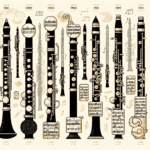The clarinet has always had an amazing capacity for storytelling. Its warm, woody tones seem to effortlessly evoke an array of emotions — from jubilation to melancholy. But what about taking your clarinet into uncharted musical territories? Let's explore Martin Freres clarinet experimental music, an intriguing combination that opens the door to stunningly creative possibilities.
Experimental music pushes traditional boundaries, encouraging musicians to think outside the box (or in our case, outside the traditional staff notation). When played on a Martin Freres clarinet, known for its precise intonation and ease of play, the results can be truly awe-inspiring!
What Is Experimental Music?
If you're scratching your head at the phrase “experimental music,” don't worry — you're not alone! This loosely defined genre focuses on breaking the rules of conventional sound, exploring new techniques, and using instruments in ways we haven't traditionally seen or heard before.
For clarinetists, traditional orchestras and concert band arrangements are wonderful, but sometimes you just want to let loose, try new things, and explore the limits of your instrument. Experimental music gives you the freedom to experiment without fear of being wrong. Each sound, no matter how unconventional, has its place here.
The Clarinet's Role in Breaking Musical Boundaries
The clarinet's versatility makes it thrive in experimental music. Its ability to produce various tones, from the airy breathiness of subtle pianissimo to robust, resonant crescendos, makes it perfect for pushing musical boundaries.
Whether you're hitting high registers with precision or letting your lowest notes rumble dramatically, a Martin Freres clarinet can handle it all. This adaptability comes from careful craftsmanship and attention to tonal balance — qualities that really shine when you're exploring new musical territory.
Top Techniques to Explore in Experimental Clarinet Playing
Here are some exciting techniques to spark your creativity when exploring Martin Freres clarinet experimental music. Grab your instrument and give these a try:
| Technique | Description |
|---|---|
| Multiphonics | Produce more than one note at a time, creating haunting, otherworldly effects. |
| Microtonal Playing | Create “in-between” notes by altering your embouchure or sliding pitch fingers slightly. |
| Key Clicks and Percussive Effects | Use the keys as percussive instruments by tapping or closing them rapidly without blowing. |
| Circular Breathing | Sustain notes indefinitely by inhaling through your nose while pushing air out of your mouth. |
| Squeak Manipulation | Embrace squeaks as compositional elements to enrich your experimental textures. |
Composers Doing Bold Things with Clarinets
Many contemporary composers have embraced the clarinet's potential in experimental music. The right equipment plays a big role when trusting your instrument to handle dynamic demands. Martin Freres clarinets are popular among educators and performers for their reliability, making them a frequent choice for experimental performances.
Try exploring works with unusual tonal clusters or shifting time signatures — they'll challenge your abilities and expand your perception of what your clarinet can do. You might even feel inspired to start composing your own experimental pieces!
Performance Spaces for Experimental Music
Here's a fun fact: you don't need a traditional concert hall to showcase your bold ideas. Experimental performances shine in unexpected venues — art galleries, outdoor parks, or even cozy house settings are perfect for clarinet innovation. Picture the sound of a Martin Freres clarinet echoing through an unusual space. It can be truly captivating!
Some settings might even encourage interaction with other performers or improvisation, blending traditional pieces with avant-garde twists based on audience energy or environmental sounds. In these moments, you're not just a musician; you're an explorer creating unique experiences.
Taking Care of Your Clarinet While Breaking Boundaries
Let's be honest: experimental music can be tough on your instrument. Before diving into new sounds, give your clarinet a thorough check-up. Seal any leaks, adjust your reeds, and clean the key mechanisms. Regular maintenance of your Martin Freres clarinet will keep it sounding great and give you the confidence to push your technical limits.
Even the best-maintained clarinet might face wear and tear when trying extended techniques. That's why proper aftercare — cleaning the mouthpiece and bore, tightening screws, and conditioning your reeds — is crucial in an experimental setting.
Reexamining the Role of Reeds
Let's talk about reeds for a moment. In experimental music, how your reed responds can make or break your sound. Some players find success mixing softer reeds for flexibility with harder reeds for sharper attacks. Play around with different combinations and see how it changes your tone!
Don't be afraid to try new fingerings with different reed strengths. This experimentation might lead to surprising sound variations, opening up techniques you never imagined before.
Whether you're gearing up for a late-night improv session or preparing an edgy new ensemble piece, pairing the right reed with a high-quality instrument like a Martin Freres clarinet sets you up for success.
Are you ready to jump into the world of experimental music? There are no rules or limits — just you, your clarinet, and endless creative possibilities.
Table of Contents
- What Is Experimental Music?
- The Clarinet's Role in Breaking Musical Boundaries
- Top Techniques to Explore in Experimental Clarinet Playing
- Composers Doing Bold Things with Clarinets
- Performance Spaces for Experimental Music
- Taking Care of Your Clarinet While Breaking Boundaries
- Reexamining the Role of Reeds







